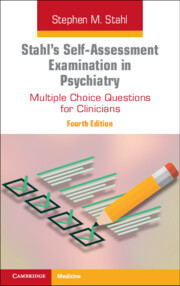Book contents
- Stahl’s Self-Assessment Examination in Psychiatry
- Stahl’s Self-Assessment Examination in Psychiatry
- Copyright page
- Contents
- Introduction/Preface
- CME/CE Information
- 1 ADHD and Its Treatment
- 2 Anxiety/Stress Disorders and Their Treatment
- 3 Basic Neuroscience and Pharmacological Concepts
- 4 Bipolar Disorder and Its Treatment
- 5 Chronic Neuropathic Pain and Its Treatment
- 6 Dementia and Its Treatment
- 7 Psychosis and Its Treatment
- 8 Sleep/Wake Disorders and Their Treatment
- 9 Substance Use/Impulsive-Compulsive Disorders and Their Treatment
- 10 Unipolar Depression and Its Treatment
- Index
- References
4 - Bipolar Disorder and Its Treatment
Published online by Cambridge University Press: 22 July 2022
- Stahl’s Self-Assessment Examination in Psychiatry
- Stahl’s Self-Assessment Examination in Psychiatry
- Copyright page
- Contents
- Introduction/Preface
- CME/CE Information
- 1 ADHD and Its Treatment
- 2 Anxiety/Stress Disorders and Their Treatment
- 3 Basic Neuroscience and Pharmacological Concepts
- 4 Bipolar Disorder and Its Treatment
- 5 Chronic Neuropathic Pain and Its Treatment
- 6 Dementia and Its Treatment
- 7 Psychosis and Its Treatment
- 8 Sleep/Wake Disorders and Their Treatment
- 9 Substance Use/Impulsive-Compulsive Disorders and Their Treatment
- 10 Unipolar Depression and Its Treatment
- Index
- References
Summary
A 25-year-old woman has recently been diagnosed with bipolar disorder, 6 years after her symptoms began. She has had no mood stabilizing treatment in that time. According to the kindling model and allostatic load hypothesis, what progressive pattern of illness would you expect this patient to have exhibited over the course of the last 6 years?
- Type
- Chapter
- Information
- Stahl's Self-Assessment Examination in PsychiatryMultiple Choice Questions for Clinicians, pp. 107 - 152Publisher: Cambridge University PressPrint publication year: 2022

